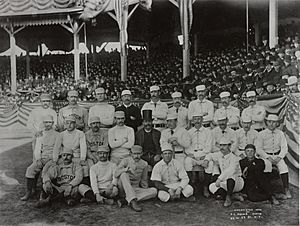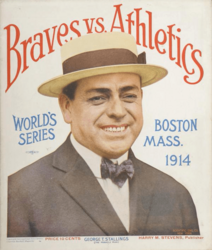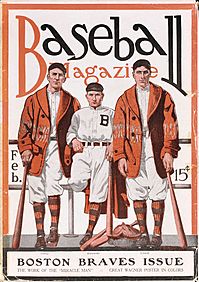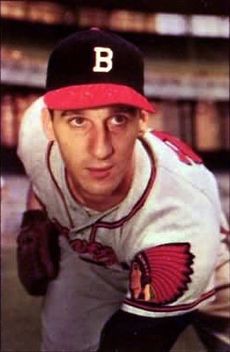Boston Braves facts for kids
The Atlanta Braves, a professional baseball team today, actually started in Boston, Massachusetts. This article tells the story of the Boston Braves from 1871 to 1952. After that, the team moved to Milwaukee, and then to Atlanta.
During their 82 years in Massachusetts, the team had many different names. These included the Red Stockings, Red Caps, Rustlers, Bees, and finally, the "Braves." While in Boston, the team won 10 National League championships. They also won a World Series in 1914. This win was amazing because the Braves were in last place as late as July 15 that year! This incredible comeback earned them the nickname "Miracle Braves."
In 1948, the Braves reached the World Series again. They had two amazing pitchers, Warren Spahn and Johnny Sain. A newspaper, Boston Post, even made a famous saying about them: "Spahn and Sain and pray for rain." The Braves played at South End Grounds from 1871 to 1914. Then they moved to Braves Field from 1915 to 1952. Braves Field is now Nickerson Field at Boston University. The Braves team, from Boston to Milwaukee to Atlanta, is the oldest professional baseball team that has played continuously.
Contents
How the Braves Started
The first all-professional baseball team, the Cincinnati Red Stockings, stopped playing after the 1870 season. Their player-manager, Harry Wright, then moved to Boston. He joined with his brother George Wright and other players to form the Boston Red Stockings. This team was one of the first members of the National Association of Professional Base Ball Players. The Boston Red Stockings and the teams that followed them are the oldest continuously playing team in American professional sports.
The Red Stockings, led by the Wright brothers, won four of the five championships in the National Association. The team became one of the first teams in the National League in 1876. Sometimes they were called the "Red Caps." By 1883, sportswriters started calling them the Beaneaters, but they still wore red.
The Red Caps/Beaneaters won eight championships in the 1800s. Their manager was Frank Selee. He was the first manager who didn't also play on the team. The 1898 team won 102 games, which was a team record for almost 100 years!
From 1900 to 1913, the team had only one winning season. In 1907, when George and John Dovey bought the team, they changed the name to the Doves. Later, when William Hepburn Russell bought the team in 1911, reporters tried calling them the Rustlers.
In 1912, the team officially became the Braves for the first time. The owner, James E. Gaffney, was part of a group in New York City called Tammany Hall. Their symbol was an Indian chief, which inspired the name.
The 1914 "Miracle" Season
Just two years after becoming the Braves, the team had one of the most amazing seasons in baseball history. They started very badly, with only 4 wins and 18 losses. It looked like they would finish in last place. On July 4, 1914, the Braves lost two games to the Brooklyn Dodgers. This made their record 26 wins and 40 losses. They were in last place, 15 games behind the New York Giants. The Giants had won the last three championships.
But then, the Braves started winning a lot! From July 6 to September 5, they won 41 games and lost only 12. On September 7 and 8, they beat the New York Giants and moved into first place. The Braves kept winning in September and October, finishing with 25 wins and 6 losses. They are the only team ever to win a championship after being in last place on the Fourth of July!
Even with their amazing comeback, the Braves were not expected to win the 1914 World Series. They were playing against Connie Mack's Philadelphia A's, who were very strong. But the Braves surprised everyone and swept the Athletics, winning the World Series! This was the first time a team completely swept the World Series without any tied games.
The Braves played the World Series games at Fenway Park. Their usual home, the South End Grounds, was too small for all the fans. Because of their success, the owner, James Gaffney, decided to build a new, modern park called Braves Field. It opened in August 1915. It was the biggest park in baseball at the time, with 40,000 seats.
Tough Years: 1915–1935

After their great seasons in 1915 and 1916, the Braves had many difficult years. For the next 19 seasons, they only had three winning seasons (1921, 1933, and 1934).
A bright spot came in 1923 when Emil Fuchs bought the team. He wanted to bring his friend, the famous pitcher Christy Mathewson, back into baseball. Mathewson was supposed to be a main owner, but he had gotten very sick during World War I. He couldn't continue in his role and passed away two years later. Fuchs then became the permanent president of the team. In 1928, the Braves got Hall of Famer Rogers Hornsby. He had a great year, batting .387, which was his seventh and final batting championship.
Fuchs wanted to build a winning team, but the team had been struggling for a long time. The Braves finally played better in 1933 and 1934 under manager Bill McKechnie. However, the Great Depression made it hard for Fuchs to make money.
Babe Ruth Comes to Boston
To get more fans and money, Fuchs made a deal with the New York Yankees to get Babe Ruth. Ruth had started his career with the Boston Red Sox. Fuchs made Ruth a vice president and assistant manager of the Braves. He also promised Ruth a share of the team's profits. Ruth had always wanted to be a manager, and Fuchs even hinted he could take over as manager soon.
At first, it seemed like Ruth was just what the team needed in 1935. On opening day, he helped the Braves score all their runs in a 4–2 win. But things quickly went downhill. In May, the team won only 4 games and lost 20, ending any hope of winning. Ruth's own health also got worse. He could still hit, but he couldn't run well, and his fielding was so bad that some pitchers threatened to stop playing if he was in the game.
Ruth soon realized that his titles of vice president and assistant manager didn't mean much. He also found out that Fuchs expected him to invest his own money in the team. Seeing the team in such a mess, Ruth retired on June 1. This was only six days after he hit the last three home runs of his career, in a very famous game. He had wanted to quit earlier, but Fuchs asked him to stay so he could play in every National League park. By this time, the Braves had won only 9 games and lost 27. Their season was practically over. They ended up with a record of 38 wins and 115 losses, which was the worst season in the team's history.
The Bees and Back to Braves: 1936–1941
Because the team was losing so much money, Fuchs had to give up control of the Braves in August 1935. The new owner, Bob Quinn, tried to change the team's image by renaming them the Boston Bees. But this didn't help the team win more games. After five difficult years, a new owner, Lou Perini, changed the nickname back to the Braves.
1948: National League Champions Again
In 1948, the team won the National League championship! They won 91 games, finishing 6 and a half games ahead of the St. Louis Cardinals. They also had many fans come to Braves Field, with over 1.4 million people attending games. This was the most fans the team had ever had in Boston.
The team's pitching was led by Hall of Famer Warren Spahn and Johnny Sain. Together, they won 39 games. The other pitchers weren't as strong. In September, a writer for Boston Post named Gerald Hern wrote a famous poem about Spahn and Sain:
- First we'll use Spahn
- then we'll use Sain
- Then an off day
- followed by rain
- Back will come Spahn
- followed by Sain
- And followed
- we hope
- by two days of rain.
This poem became very popular and is often shortened to "Spahn, Sain, then pray for rain."
The Braves lost the 1948 World Series in six games to the Cleveland Indians. This was the last big moment for the Braves in Boston.
Final Years in Boston: 1949–1952
Sam Jethroe
On April 18, 1950, Sam "Jet" Jethroe joined the Boston Braves. He had been traded from the Brooklyn Dodgers. Jethroe was the first African-American player to play for the Boston Braves. He was named National League Rookie of the Year in 1950, at age 32. He hit .273 with 18 home runs and led the National League with 35 stolen bases. He also led the league in stolen bases in 1951. Jethroe was a former star in the Negro leagues and a military veteran. He is still the oldest player to win the Rookie of the Year award.
Moving to Milwaukee
After 1948, the Braves had four average seasons. Fewer and fewer fans came to their games, even though Braves Field was known as a family-friendly park.
For 50 years, no major league baseball team had moved to a new city. The Braves played their last home game in Boston on September 21, 1952. They lost to the Brooklyn Dodgers 8–2. Only 8,822 fans were there. For the whole 1952 season, fewer than 282,000 people came to games.
On March 13, 1953, owner Lou Perini announced he wanted to move the Braves to Milwaukee. This day became known as "Black Friday" in Boston because fans were sad to see the team leave after 80 years. Perini said the main reason for the move was the low attendance. He also said he had bought out his business partners. Milwaukee was chosen because the Braves had their main minor league team, the Brewers, there.
The National League approved the move after a meeting on March 18, 1953. The team moved to Milwaukee right away. The All-Star Game had been planned for Braves Field, but it was moved to Cincinnati.
After the Braves moved to Milwaukee in 1953, the Braves Field site was sold to Boston University. It was rebuilt as Nickerson Field. The Braves Field scoreboard was sold to the Kansas City A's and used at their stadium.
Famous Boston Braves Players
Here are some notable players who played for the Boston Braves:
- Dave Bancroft – Played for Boston Braves (1924–1927), in the Hall of Fame (1971)
- Alvin Dark – Played for Boston Braves (1946–1949), Rookie of the Year (1948)
- Bob Elliott – Played for Boston Braves (1947–1951), National League MVP (1947)
- Johnny Evers – Played for Boston Braves (1914–1917, 1929), in the Hall of Fame (1946)
- Hank Gowdy – Played for Boston Braves (1911–1917, 1919–1923, and 1929–1930)
- Del Crandall – Played for Boston Braves (1949–1952), 11-time All-Star
- Sam Jethroe – Played for Boston Braves (1950–1952), Rookie of the Year (1950)
- Bill McKechnie – Played for Boston Braves (1913), manager (1930–1937), in the Hall of Fame (1962)
- Rabbit Maranville – Played for Boston Braves (1912–1920, 1929–1935), in the Hall of Fame (1954)
- Eddie Mathews – Played for Boston Braves (1952), in the Hall of Fame (1978)
- Johnny Sain – Played for Boston Braves (1942–1951), 3-time All-Star, key pitcher in 1948
- Kid Nichols – Played for Boston Beaneaters (1890–1901), in the Hall of Fame (1949)
- Babe Ruth – Played for Boston Braves (1935), in the Hall of Fame (1936)
- Billy Southworth – Played for Boston Braves (1921–1923), manager (1946–1949, 1950–1951), in the Hall of Fame (2008)
- Warren Spahn – Played for Boston Braves (1942, 1946–1952), in the Hall of Fame (1973)
- Casey Stengel – Played for Boston Braves (1924–1925), manager (1938–1943), in the Hall of Fame (1966)
- King Kelly – Played for Boston Beaneaters (1887–1889), manager (1887), in the Hall of Fame (1945)
Images for kids







